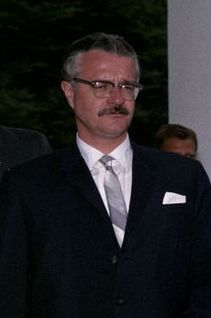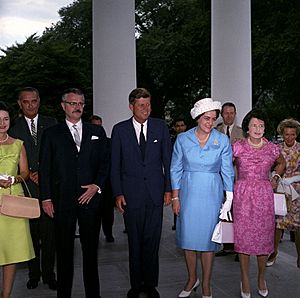Carlos Julio Arosemena Monroy facts for kids
Quick facts for kids
Carlos Julio Arosemena Monroy
|
|
|---|---|
 |
|
| 31st President of Ecuador | |
| In office 7 November 1961 – 11 July 1963 |
|
| Vice President | Reynaldo Varea |
| Preceded by | José María Velasco Ibarra |
| Succeeded by | Ramón Castro Jijón |
| Vice President of Ecuador | |
| In office 1960–1961 |
|
| President | José María Velasco Ibarra |
| Preceded by | Francisco Illingworth Icaza |
| Succeeded by | Reinaldo Varea Donoso |
| Personal details | |
| Born |
Carlos Julio Arosemena Monroy
24 August 1919 Guayaquil, Ecuador |
| Died | 5 March 2004 (aged 84) Guayaquil, Ecuador |
| Political party | National Velasquista Federation |
| Spouse |
Gladys Peet Landin
(m. 1946) |
| Children | 7 |
| Alma mater | University of Guayaquil |
Carlos Julio Arosemena Monroy (born August 24, 1919, died March 5, 2004) was an important politician from Ecuador. He served as the Vice President starting in 1960. Later, he became the President of Ecuador from November 7, 1961, to July 11, 1963. This happened after the previous president, José María Velasco Ibarra, was removed from office.
Early Life and Political Career
Carlos Julio Arosemena Monroy was born in Guayaquil, Ecuador. His father, Carlos Julio Arosemena Tola, was also a former president of Ecuador. His mother was Laura Monroy Garaycoa.
Before becoming president, Carlos Julio Arosemena Monroy held other important roles. In 1952, he was the President of the Chamber of Deputies. This is a key position in the country's law-making body. As Vice President, he also served as the President of the Senate.
Time as President
Carlos Julio Arosemena Monroy became president during a time of big changes in Latin America. Many countries were seeing new political ideas and military governments.
During his time as president, he worked on several important projects for Ecuador:
- He improved the country's phone and communication systems.
- He helped create TAME, which is Ecuador's national airline.
- He supported the creation of two universities in Guayaquil. These were the Secular University and the Catholic University.
- He started building new roads across the country.
- He introduced the "thirteenth month's salary." This meant workers received an extra month's pay each year, which helped many families.
His support for certain political movements in other countries caused some disagreements. This led to ongoing conflicts with Ecuador's Congress and military leaders.

End of Presidency
While he was president, there were two attempts to remove him from office. He was eventually overthrown by the Military Junta of 1963. This happened after he spoke critically about the United States government and its ambassador to Ecuador at the time.
See also
 In Spanish: Carlos Julio Arosemena Monroy para niños
In Spanish: Carlos Julio Arosemena Monroy para niños

